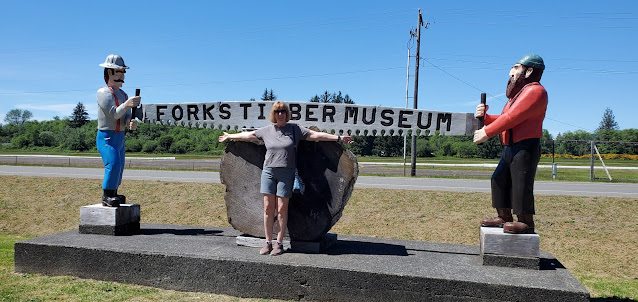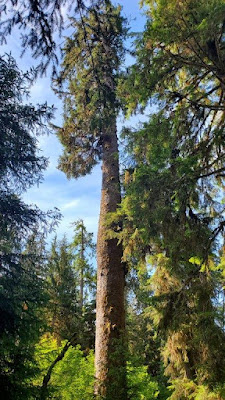We left the Oceana RV Park in Ocean Shores and drove north on Hwy 101 to Forks, Washington. The drive was along a two lane road lined with wild flowers and big trees.
We would see these large piles of tree limbs and stumps and wondered why they are left that way?
We arrived at the Elks Lodge in Forks, Washington and almost have the place to ourselves! Just one other RV is parked with us.
The Fork Elks have a real nice property.
The Timber Museum is at the entrance to the town of Forks. We're not big museum goers but we did pay to enter this museum and it was interesting.
I got my question answered at the museum.
Questions Often Asked About Logging
Why do you clear cut?
Efficiency. Maneuvering a timber harvester through a forest to remove only a few trees is difficult, especially on steep slopes or wet areas. Also seedlings of desirable tree species like Douglas Fir require full sun to grow and clear cutting guarantees this.
Why are those "debris piles" or "eco-stacks" left behind? Do they get re-cycled or burned?
The ground is cleared of logging debris and made into piles to provide better conditions for seedling trees. After dying a few months to a year the piles are burned, usually in early fall after forest fire danger is past.
Why are the big stumps left behind?
Big stumps are deeply anchored to the ground, as they have to keep 200+ foot tall trees upright in hurricane force winds. Even the biggest bulldozers are challenged to dig them up. Also if you do dig them up, what then? Gravel and boulders are embedded in them making it impossible to process with wood cutting tools. In time, they decay returning nutrients to the soil.
Why don't they re-plant the trees right away?
Look more closely, a seedling tree is just a single stem only a few inches tall. Re-planting is done within 12 to 18 months after harvesting and, if possible, not until the debris piles have been burned. Tree planting is done in the winter so the seedlings have several months of wet conditions to get established before summer drought.
Bull of the Wood:
This person is in charge of the woods operation. In the old days the toughest man on the crew. Nowadays still a pretty tough logger.
Bushler:
Logger who cuts down trees. He is paid by the "bushel", i.e. the amount of wood he cuts. Because of the danger, other logging activity cannot be done while trees are being felled, so he, and usually a partner works alone.
Bucker:
Logger who cuts felded trees to desired log lengths.
Hook Tender:
Boss of the rigging crew, i.e, of chokemen, chasers, etc. Also directs movement of rigging.
Chokerman (Choker Setter):
Logger who attaches chokers to logs to allow them to be yarded to the landing.
Chaser:
Logger who unhooks chokers from logs after they are yarded to the landing.
Whistle Punk:
Usually a kid who signaled to yarder engineer when to move the rigging. No longer necessary because radio equipment is small enough to be carried by a chokeman or hook tender.
Second Loader:
Prepares logs for loading onto trucks, trimming limbs, marking, ets. Signals to loader machine operator on positioning of logs on trucks.
Donkey Puncher:
Not a man who is cruel to mules but the operator of the heavy diesel that powers loaders and yarders. The name is a relic from the days of steam. Nowadays the term "yard engineer" is more common.
I'm glad we visited the Timber Museum.
Another day we drove about 50 minutes to the Hoh Rain Forest Visitor Center section of Olympic National Park.
 |
| Photo courtesy of Google Images |
 |
| Western Red Cedar, Sitka Spruce, Western Hemlock, and Douglas Fir |
 |
| Bark from the Sitka Spruce and Western Hemlock |
We did the 1.2 mile Spruce Trail then went back to the Visitor's Center to listened to a Ranger talk about this area of Olympic National Park.
Can you tell I love big trees and ferns?
 |
| Hoh River |
Look at the roots on this tree that fell in the forest! And look at the trees growing from the fallen tree. The fallen tree is now considered a nurse log.
A nurse log is a fallen tree which, as it decays, provides ecological facilitation to seedlings.
 |
| Taft Creek |
I earned another Junior Ranger badge. This is #43.
After lunch that we ate on the tail gate of our truck, we walked around the campground to kill a little time before our Ranger hike. Unexpectedly we saw Mr. Burns, a huge Roosevelt Elk with giant antlers.
We did the Ranger led Hall
of Mosses hike for about 90 minutes. We often enjoy the Ranger hikes because they stop and point out interesting things and provide more information about the things we are seeing.
 |
| Look at the differences in bark on these trees. |
Hall of Mosses
Lush beards of clubmoss are attached to boughs but feed only on air and light. The rain forest atmosphere supplies enough moisture and wind-born nutrients.
Certain trees like these bigleaf maples support denser cluster of airplants or epiphytes (lichens and hanging mosses.)
Nurselogs
When a big tree falls it can provide a state for new life. Hemlock and spruce seedlings, unable to survive on the tangled forest floor, absorb minerals, moisture and warmth from the decaying trunk. Even on this perch competition is fierce. Only a few seedlings last. After their roots reach soil, new trees often seem to stand on stilts as the nurselog moulders away.
Lastly we walked the Hoh River Trail to Mineral Creek Falls (2.7 mi each way). That was a long walk on mostly flat trail but I was tired. The falls were nice but it seemed like we would never get there. Once we arrived we hiked up a little further to see the upper falls.
 |
| Hey, your hat is in the way! |
 |
| Can you see the snow capped mountain through the trees? |
Surprisingly we had no rain during our time in the Hoh Rain Forest! We had beautiful weather.
Here is the area covered in this blog entry.
We're continuing our travels on the Olympic Peninsula and popping over to Victoria, Canada for a day in the next entry. Thanks for following along.
BTW, if you leave a comment, please include your name or initials so I know who wrote it. Most of the time all I see is the comment is from Anonymous.















































































More great pictures! Interesting museum. Love the huge Elk!
ReplyDeleteIt was great just walking around in the rain forest, and seeing everything nice and green.
ReplyDeleteWow really nice story of this area, seeing all that green makes me want to get there that much sooner! Great job .. thanks for hiking the trail to the falls, otherwise I would never get to see them. lol Can’t wait for your next adventure.
ReplyDelete